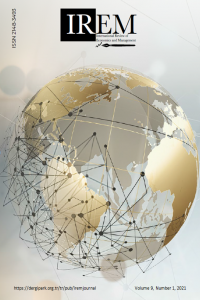FOREIGN DIRECT INVESTMENTS AND ECONOMİC GROWTH: HOW WELL DOES THE TECHNOLOGY CHANNEL WORK IN TURKEY?
Foreign direkt invesment, Economic growth, Manufacturing Industry
FOREIGN DIRECT INVESTMENTS AND ECONOMİC GROWTH: HOW WELL DOES THE TECHNOLOGY CHANNEL WORK IN TURKEY?
___
- Chimobi, Omoke Philip (2010). “The Estimation of Longrun Relationship between Economic Growth, Investment and Export in Nigeria”. International Journal of Business and Management, 5 (4): 215-222.
- Doytch, Nadia, and Merih Uctum (2011). “Does the Worldwide Shift of FDI from Manufacturing to Services Accelerate Economic Growth? A GMM Estimation Study”. Journal of International Money and Finance, 30 (3): 410-427
- Duce, Maitena (2003). “Definitions of Foreign Direct Investment (FDI): A Methodological Note”. Paper for the CGFS Working Group, Banco de Espana. Madrid.
- Durlauf, Steven N., and Lawrence E. Blume (2008). The New Palgrave Dictionary of Economics. Second Edition.
- Enders, Walter (1995). Applied Econometric Time Series. New York: John Wiley & Sons, Inc.
- Hansen, Henrik, and John Rand (2005). “On the Causal Links between FDI and Growth in Developing Countries”, UNU-WIDER. United Nations University (UNU). Research Paper No. 2005/31.
- IMF (2009). Balance of Payments and International Investment Position Manual. Sixth Edition (BPM6). Washington. D.C.: IMF.
- Kar, Muhsin ve Fatma Tatlısöz (2008). “Türkiye’de Doğrudan Yabancı Sermaye Hareketlerini Belirleyen Faktörlerin Ekonometrik Analizi”, KMU İİBF Dergisi, 10 (14): 436-458.
- Lipsey, Robert E., and Fredrik Sjöholm (2005). “The Impact of Inward FDI on Host Countries: Why Such Different Answers?” in Theodore H. Moran, Edward M. Graham, and Magnus Blomström (eds.). Does Foreign Direct Investment Promote Development?. Washington: Institute for International Economics Center for Global Development.
- Saggi, Kamal (2002). “Trade, Foreign Direct Investment, and International Technology Transfer: A Survey”, The World Bank Research Observer, 17 (2): 191-235.
- Sonmez, Alper and M. Teoman Pamukcu (2011). “Foreign Direct Investment and Technology Spillovers in the Turkish Manufacturing Industry”. STPS Working Papers 11/03. STPS-Science and Technology Policy Studies Center. Middle East Technical University.
- Turan Koyuncu, Fatma (2010). “Türkiye’de Seçilmiş Makroekonomik Değişkenlerin Doğrudan Yabancı Sermaye Yatırımları Üzerindeki Etkisinin Yapısal VAR Analizi: 1990-2009 Dönemi”, Ekonomi Bilimleri Dergisi, 2 (1): 55-62.
- Wang, Miao (2009). “Manufacturing FDI and Economic Growth: Evidence from Asian Economies”, Applied Economics, 41 (8): 991-1002.
- ISSN: 2148-3493
- Yayın Aralığı: Yıllık
- Başlangıç: 2013
- Yayıncı: Gökhan ÖZER
Sean PRADHAN, Adem BOYUKASLAN, Fatih ECER
FARKLI GELİR GRUPLARINDAKİ ÜLKELERDE FİNANSAL GELİŞME VE EKONOMİK BÜYÜME İLİŞKİSİNİN ANALİZİ
FOREIGN DIRECT INVESTMENTS AND ECONOMİC GROWTH: HOW WELL DOES THE TECHNOLOGY CHANNEL WORK IN TURKEY?
Yusuf BAYRAKTUTAN, Meltem TARI ÖZGÜR
HOW DID TURKEY'S EU EXPORTS AFFECTED BY THE 2008 FINANCIAL CRISIS?
